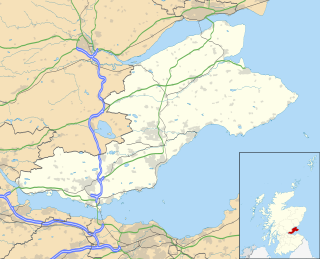
Aberdour is a scenic and historic village on the south coast of Fife, Scotland. It is on the north shore of the Firth of Forth, looking south to the island of Inchcolm and its Abbey, and to Leith and Edinburgh beyond. According to the 2011 census, the village has a population of 1,633.

Pennan is a small village in Aberdeenshire, Scotland, consisting of a small harbour and a single row of homes, including a hotel. It is on the north-facing coast and is about one hour's drive from Aberdeen. It was formerly known as St Magnus Haven or Auchmedden.

Peterhead is a town in Aberdeenshire, Scotland. It is Aberdeenshire's biggest settlement, with a population of 18,537 at the 2011 Census. It is also the largest fishing port in the United Kingdom for total landings by UK vessels, according to a 2019 survey.

Crimonmogate is an estate near Crimond, Aberdeenshire. The estate formed part of Lonmay parish, dates back to the 14th century, and was included in the lands owned by the powerful Earls of Erroll. The estate was sold by Mary Hay, 14th Countess of Erroll, in the 1730s.

Longside is a village located in Aberdeenshire, Scotland and consists of a single main street. It lies seven miles inland from Peterhead and two miles from Mintlaw on the A950. Its population in 2001 was 721. The River Ugie flows through it.

Glenbuchat Castle is a historic Z plan Scottish castle built in 1590 for John Gordon of Cairnbarrow to mark his wedding. It is located above the River Don, near Kildrummy, Aberdeenshire. The building is roofless, but otherwise in fairly good repair.
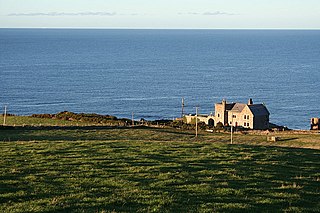
Dundarg Castle is a ruined castle about 2 kilometres (1.2 mi) north-northeast of New Aberdour, Aberdeenshire, Scotland, built within the ramparts of an earlier Iron Age promontory fort. It was described by W. Douglas Simpson as one of the nine castles of the Knuckle, referring to the rocky headland of north-east Aberdeenshire, and by Charles McKean as "Scotland's answer to Tintagel". It became a small Celtic monastery for a period.

Tyrie is a hamlet and parish in the Banff and Buchan district of Aberdeenshire, north-east Scotland. Tyrie is located on the A98 road, around 5.5 miles (8.9 km) south-west of Fraserburgh. Tyrie parish includes the larger settlement of New Pitsligo, 5 miles (8.0 km) to the south. There is a primary school in the village. Tyrie's St Andrew's Parish Church was built in 1800 and is a category B listed building. The church contains a Pictish symbol stone, known as the Raven Stone, which was discovered on the site of the old parish church. The ecclesiastical parish was united with Strichen parish in 2002.

Hatton Castle is almost three miles (4.8 km) south-east of Turriff, Aberdeenshire in the north-east of Scotland. Formerly known as Balquholly Castle, sometimes spelt as Balquollie, it was renamed in 1814. The 17,994 square feet (1,671.7 m2) mansion was designated a category A listed building in 1972; the gardens are included in the Inventory of Gardens and Designed Landscapes in Scotland.
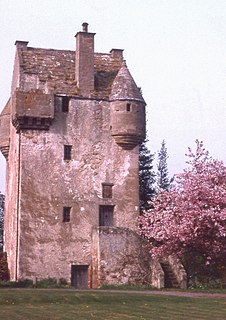
Coxton Tower is a late sixteenth-century tower house in Moray, Scotland. Heavily fortified, it was built around 1590, with substantive repairs in 1635 and 1645, but its design is reminiscent of much older buildings. It has not been occupied since around 1867 except to house Canadian soldiers during the Second World War, but was renovated in 2001 to help protect the fabric of the structure, which is designated a Category A listed building.
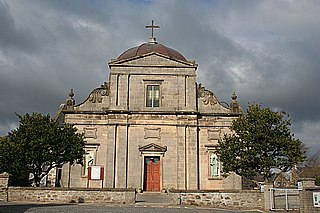
William Robertson was a Scottish architect. Born in Lonmay in Aberdeenshire, he started his career in Cullen, Moray, then moved to Elgin around 1821, where he practised for the rest of his life. He established himself as the foremost architect of his period north of Aberdeen, described by Charles McKean as "possibly the north of Scotland's first native classical architect of substance." His practice was continued by his nephews Alexander and William Reid, and then by their partners and successors J and W Wittet.

Brethren Meeting House is a Category C listed building at 26 Gordon Street in Boddam, Aberdeenshire, Scotland. It was formerly a late Victorian-era Wesleyan church. A bellcote is on the gable, without a bell but with a "spiky" finial in place.
32 Broad Street is a Category B listed building at 32 Broad Street in Peterhead, Aberdeenshire, Scotland. It was built in 1858. Originally a Union Bank of Scotland, it is now home to a Bank of Scotland.
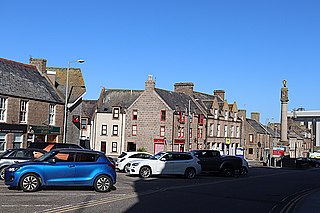
The Reform Monument is a Category B listed monument on Broad Street, at its junction with Longate, in Peterhead, Scotland, built in 1833. A Roman doric column, it is surmounted by arms of Earl Marischal, inspired by the gateway of Inverugie Castle.
Kirkburn House is a Category B listed building on South Road in Peterhead, Aberdeenshire, Scotland. It was the manse for the adjacent, now-ruined Old St Peter’s Church. Its name refers to the now-culverted burn in the hollow alongside the building.

The Howe o'Buchan House is a Category C listed building on Inverugie Road in Peterhead, Aberdeenshire, Scotland. It dates from 1840, and is a two-storey residential building. The house contains a marble chimneypiece that dates from circa 1805. It also contains a sculptured panel and bannisters which originated from Brucklay Castle.

The Fish-House is a Category B listed building on Golf Road in the Inverugie area of Peterhead, Aberdeenshire, Scotland. One of the two right-angled blocks dates from 1585, making it the oldest building in Peterhead. Walker and Woodworth state the structure was built as a coastal store for Inverugie Castle by William Keith, 4th Earl Marischal, whose initials are on a skewputt. They also state that it was "rebuilt c. 1801," but without clarification as to which building.

75 Broad Street is a Category B listed building in Peterhead, Aberdeenshire, Scotland. It dates to 1835, and was originally a Clydesdale Bank. It is believed to have been designed by Archibald Simpson.

The Bath House is a Category B listed building in Peterhead, Aberdeenshire, Scotland. Located at 7 Bath Street, it dates to around 1812.

House of Memsie is a Category A listed country house and estate in Memsie, Aberdeenshire, Scotland. It dates to around 1760, and it received its historic designation in 1971. It was formerly the home of the Fraser family for over three hundred years. It was sold to Lord Saltoun in the early 19th century. A Captain Dalrymple was another previous owner. Historian Charles McKean describes it as a "smaller and more decorative version of Aberdour House".


















